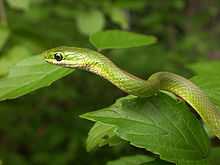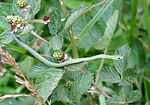Opheodrys aestivus
| Rough Green Snake Opheodrys aestivus | |
|---|---|
 | |
| Rough Green Snake | |
| Conservation status | |
| Scientific classification | |
| Kingdom: | Animalia |
| Phylum: | Chordata |
| Subphylum: | Vertebrata |
| Class: | Reptilia |
| Order: | Squamata |
| Suborder: | Serpentes |
| Family: | Colubridae |
| Subfamily: | Colubrinae |
| Genus: | Opheodrys |
| Species: | O. aestivus |
| Binomial name | |
| Opheodrys aestivus (Linnaeus, 1766) | |
| Synonyms | |
| |
Opheodrys aestivus, commonly known as the rough green snake, is a nonvenomous North American colubrid. It is sometimes called grass snake or green grass snake, but these names are more commonly applied to the smooth green snake (Opheodrys vernalis). The European colubrid called grass snake (Natrix natrix) is unrelated. The rough green snake is docile, often allowing close approach by humans, and seldom bites.
Description
The rough green snake (Opheodrys aestivus) is bright green above and has a yellowish belly, affording it excellent camouflage in green vegetation. It has keeled dorsal scales, which are arranged in 17 rows at midbody. It grows up to 116 cm (45½ inches) in total length[3] and is very thin.
Geographic range
The rough green snake ranges throughout the Southeastern United States, from Florida, north to New Jersey, Indiana, and west to Central Texas. The snake is commonly found in the Piedmont and Atlantic Coastal Plain, but is not found in the higher elevations of the Appalachian Mountains. It is also found in northeastern Mexico, including the state of Tamaulipas and eastern Nuevo León.
Habitat
Its preferred habitat is moist meadows and woodlands, often near water. It is highly arboreal, frequently found climbing in low vegetation, and is also a good swimmer. However, it is often found on the ground as well. Unlike many snakes, it is largely diurnal.
Diet
Its diet consists mostly of insects and other terrestrial arthropods, but some snails and tree frogs are eaten as well. This snake is not a constrictor—most prey are grabbed and simply swallowed alive.

Predation
Predators of the rough green snake include birds and other snakes, such as the eastern racer (Coluber constrictor) and the eastern king snake (Lampropeltis getula).
Reproduction
The rough green snake breeds in spring, and sometimes again in fall. Females lay 2-14 eggs, occasionally in a communal nest shared by more than one female. Up to 75 eggs have been found in one such nest. The nest site varies: under boards, under bark in rotting stumps, in deep mulch, or under a rock. Hatchlings from spring breeding typically emerge in August or September, and are about 18–20 cm (7-8 inches) in total length.
Conservation status
The rough green snake is widespread and is not of conservation concern, in general. However urban development, especially the reduction of vegetation near waterways, may reduce their numbers. Many are killed on roads, and they may be susceptible to poisoning by pesticides used on their insect prey.
Subspecies
- Northern rough green snake, Opheodrys aestivus aestivus (Linnaeus, 1766)
- Florida rough green snake, Opheodrys aestivus carinatus Grobman, 1984
References
- ↑ Boulenger, G.A. 1894. Catalogue of the Snakes in the British Museum (Natural History), Volume II., Containing the Conclusion of the Colubridæ Aglyphæ. Trustees of the British Museum. London. xi + 382 pp., Plates I.- XX. (Contia æstiva, p. 258.)
- ↑ Stejneger, L., & T. Barbour. 1917. A Check List of North American Amphibians and Reptiles. Harvard University Press. Cambridge, Massachusetts. 125 pp. (Opheodrys aestivus, p. 78.)
- ↑ Smith, H.M., and E.D. Brodie, Jr. 1982. Reptiles of North America: A Guide to Field Identification. Golden Press. New York. 240 pp. ISBN 0-307-13666-3. (Opheodrys aestivus, pp. 188-189.)
Further reading
- Aardema et al. Amphibians and Reptiles of North Carolina—accessed 29 May 2006
- Conant et al. (1998). A Field Guide to Reptiles and Amphibians of Eastern and Central North America. Boston: Houghton Mifflin. ISBN 0-395-90452-8.
- Cook, Will. Carolina Nature—accessed 29 May 2006.
- Gibbons, Whit, Michael E. Dorcas, and J. Whitfield Gibbons (2005). Snakes Of The Southeast. Athens, Georgia: University of Georgia Press. ISBN 0-8203-2652-6.
- Martof et al. (1980). Amphibians and Reptiles of the Carolinas and Virginia. Chapel Hill: University of North Carolina Press. ISBN 0-8078-4252-4.
- Myers, P., R. Espinosa, C. S. Parr, T. Jones, G. S. Hammond, and T. A. Dewey. 2006. Animal Diversity Web. Accessed May 29, 2006.
- Palmer, William M., Alvin L. Braswell, Renaldo Kuhler (1995). Reptiles of North Carolina. Chapel Hill: University of North Carolina Press. ISBN 0-8078-2158-6.
- Schmidt, K.P., and D.D. Davis. 1941. Field Book of Snakes of the United States and Canada. G.P. Putnam's Sons. New York. 365 pp. (Opheodrys aestivus, pp. 118–120, Figure 27. + p. 332, Plate 12.)
- University of Georgia, Savannah River Ecological Laboratory, Animal Fact Sheets—accessed 1 June 2006
- University of Georgia, Savannah River Ecological Laboratory, Reptiles and Amphibians of South Carolina and Georgia—accessed 1 June 2006
- Wright, A.H., and A.A. Wright. 1957. Handbook of Snakes of the United States and Canada. Comstock. Ithaca and London. 1105 pp. (in 2 volumes) (Opheodrys aestivus, pp. 551–555, Map 43., Figure 164.)
| Wikimedia Commons has media related to Opheodrys aestivus. |
